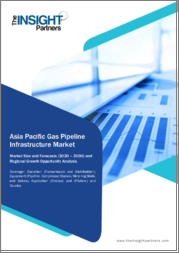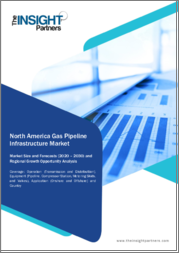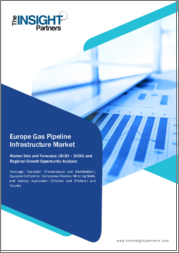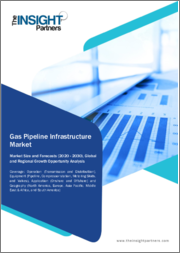
|
시장보고서
상품코드
1562421
아시아태평양의 가스 파이프라인 인프라 시장 예측(-2030년) : 지역별 분석 - 사업별, 설비별, 용도별Asia Pacific Gas Pipeline Infrastructure Market Forecast to 2030 - Regional Analysis - by Operation (Transmission and Distribution), Equipment (Pipeline, Compressor Station, Metering Skids, and Others), and Application (Onshore and Offshore) |
||||||
아시아태평양의 가스 파이프라인 인프라 시장은 2022년 6,309억 달러에서 2030년 1조 749억 달러로 성장할 것으로 예상되며, 2022-2030년 CAGR은 6.9%를 기록할 것으로 추정됩니다.
에너지 수요 증가로 아시아태평양의 가스 파이프라인 인프라 시장이 성장
인구 증가와 도시화의 진전은 세계 에너지 소비를 증가시키는 몇 가지 요인입니다. 예를 들어, 인도는 소득 증가와 생활수준의 향상으로 세계 3위의 에너지 소비국이 되었습니다. 중국, 미국에 이어 인도의 에너지 소비량은 2,000년 이후 두 배로 증가했지만, 수요의 80%는 여전히 석유, 석탄, 고체 바이오매스로 충당되고 있습니다. 인도 에너지 포트폴리오에서 천연가스가 차지하는 비중은 6%에 불과합니다. 그러나 향후 20년간 인도의 가스 소비량은 에너지 포트폴리오에서 차지하는 비중이 두 배 이상 증가할 것으로 예상됩니다. 천연가스는 발전용으로 사용할 수 있는 잠재력이 있어 수요를 증가시키고 있습니다. 또한, 러시아-우크라이나 전쟁으로 인한 유럽 내 에너지 불안이 커지면서 일부 국가 정부도 천연가스 사용을 늘리고 있습니다. 이러한 에너지 수요 증가는 가스 파이프라인 인프라 시장의 성장을 촉진하고 있습니다.
아시아태평양의 가스 파이프라인 인프라 시장 개요
천연가스 발전은 화석연료 중 배출량이 가장 적고 환경에 미치는 영향이 가장 적은 LNG가 주도하고 있습니다. 청정에너지원으로서 LNG는 아시아태평양 여러 국가의 에너지 수요를 충족시킬 수 있을 것으로 추정됩니다. 중국, 일본, 인도는 아시아태평양의 가스 파이프라인 인프라 시장에서 활동하는 주요 국가 중 일부입니다. 천연가스 생산 및 유통을 지원하기 위한 정부의 규칙, 규제 및 개혁은 아시아태평양의 가스 파이프라인 인프라 개발을 촉진하는 주요 요인입니다. 가스 공급과 접근성을 개선하기 위한 가스 파이프라인 확장에 대한 정부의 융자 및 지원도 아시아태평양의 가스 파이프라인 인프라 시장에 영향을 미치고 있습니다. 아시아태평양의 다양한 상업 및 산업 부문에서 천연가스 사용 확대는 곧 가스 파이프라인 인프라 시장의 성장을 촉진할 것으로 예상됩니다. 탄소 중립 사회 구현에 대한 관심이 높아지면서 다양한 상업 및 산업 부문에서 천연가스의 적용과 수요가 증가하고 있습니다. 또한, 발전용 천연가스 수요 증가도 가스 파이프라인 인프라 시장의 성장에 큰 힘이 되고 있습니다. 일본석유자원개발(JAPEX)은 일본 내 가스 인프라의 주요 기업 중 하나로, 주로 국내 가스 공급 시스템에 중점을 두고 최대 800km 이상의 고압 가스 파이프라인 네트워크를 구축하고 있습니다. 이 네트워크는 국내 석유 및 가스 기지와 LNG 기지 사이를 연결하고 파이프라인을 통해 고객에게 천연가스를 공급합니다. 니가타-센다이 가스관, 소마-이와누마 가스관, 시로이시-코리야마 가스관은 일본의 주요 가스관 네트워크의 일부입니다. 일본 가스 부문은 몇 가지 강력한 협력 관계를 확인했으며 향후 몇 년 동안 생산 사업을 강화할 것으로 예상되며, JX Nippon Oil & Gas Development는 현재 석유 및 가스 부문에서 입지를 강화하기 위해 일본 해양 시추 주식회사(JDC)의 인수를 추진하고 있습니다. JDC는 2023년 2월, 태국 부알안 유전에서 하쿠류-11 잭업 리그의 시추를 지원하는 계약을 체결하는 등 일본 기업들은 각국에서 강력한 해상 가스 사업 계약을 체결하고 있습니다. 이러한 신흥국 시장 개척이 일본 가스 파이프라인 인프라 시장의 성장을 견인하고 있습니다.
아시아태평양의 가스 파이프라인 인프라 시장 매출 및 2030년까지의 전망(10억 달러)
아시아태평양의 가스 파이프라인 인프라 시장 세분화
아시아태평양의 가스 파이프라인 인프라 시장은 사업, 설비, 용도, 국가별로 구분됩니다.
사업을 기준으로 아시아태평양의 가스 파이프라인 인프라 시장은 전송과 유통으로 나뉘며, 2022년 아시아태평양의 가스 파이프라인 인프라 시장에서 유통 부문이 큰 비중을 차지했습니다.
설비 측면에서 아시아태평양의 가스 파이프라인 인프라 시장은 파이프라인, 압축기 스테이션, 계량 스키드, 밸브로 분류됩니다. 파이프라인 부문은 2022년 아시아태평양의 가스 파이프라인 인프라 시장에서 가장 큰 점유율을 차지했습니다.
용도별로 아시아태평양의 가스 파이프라인 인프라 시장은 육상과 해상으로 구분되며, 2022년 아시아태평양의 가스 파이프라인 인프라 시장에서 육상 부문이 큰 비중을 차지했습니다.
국가별로는 아시아태평양의 가스 파이프라인 인프라 시장은 중국, 일본, 인도, 인도네시아, 인도네시아, 호주, 기타 아시아태평양으로 구분되며, 2022년 아시아태평양의 가스 파이프라인 인프라 시장은 일본이 독점하고 있습니다.
Berkshire Hathaway Inc, Pipeline Infrastructure Ltd, Saipem SpA, China Petroleum &Chemical Corp는 아시아태평양의 가스 파이프라인 인프라 시장에서 활동하는 주요 기업입니다.
목차
제1장 소개
제2장 주요 요약
- 주요 인사이트
- 시장 매력
제3장 조사 방법
- 조사 범위
- 2차 조사
- 1차 조사
제4장 가스 파이프라인 인프라 시장 상황
- 소개
- 생태계 분석
- 생산
- 트랜스미션
- 배급
- 최종사용자
제5장 아시아태평양의 가스 파이프라인 인프라 시장 : 주요 산업 역학
- 시장 성장 촉진요인
- 천연가스 수요 증가
- 에너지 수요 증가
- 장거리의 비용 효율
- 시장 성장 억제요인
- 태양광이나 풍력에 의한 재생에너지 발전에의 급속한 확대와 투자
- 시장 기회
- 재생에너지와의 통합
- 시장 동향
- 오프쇼어 가스 산업의 발전
- 성장 촉진요인과 저해요인의 영향
제6장 가스 파이프라인 인프라 시장 : 아시아태평양 시장 분석
- 가스 파이프라인 인프라 시장 매출(2020-2030년)
- 가스 파이프라인 인프라 시장 예측과 분석
제7장 아시아태평양의 가스 파이프라인 인프라 시장 분석 - 사업
- 소개
- 가스 파이프라인 인프라 시장 : 사업별(2022년, 2030년)
- 송전
- 송전 시장 : 매출과 2030년까지 예측
- 배전
- 배전 시장, 매출과 2030년까지 예측
제8장 아시아태평양의 가스 파이프라인 인프라 시장 분석 - 설비
- 소개
- 가스 파이프라인 인프라 시장 : 설비별(2022년, 2030년)
- 파이프라인
- 파이프라인 시장, 매출과 2030년까지 예측
- 밸브
- 밸브 개요
- 밸브 시장, 매출과 2030년까지 예측
- 컴프레서 스테이션
- 컴프레서 스테이션 개요
- 컴프레서 스테이션 시장, 매출과 2030년까지 예측
- 계량 스키드
- 계량 스키드 시장, 매출과 2030년까지 예측
제9장 아시아태평양의 가스 파이프라인 인프라 시장 분석 : 용도
- 소개
- 가스 파이프라인 인프라 시장 : 용도별(2022년, 2030년)
- 온쇼어
- 온쇼어
- 온쇼어 시장 매출과 2030년까지 예측
- 오프쇼어
- 오프쇼어 개요
- 오프쇼어 시장, 매출과 2030년까지 예측
제10장 아시아태평양의 가스 파이프라인 인프라 시장 : 국가별 분석
- 아시아태평양 시장 개요
- 호주
- 중국
- 일본
- 인도
- 인도네시아
- 기타 아시아태평양
제11장 업계 상황
- 소개
- 시장 이니셔티브
- 인수합병
제12장 기업 기업 개요
- Berkshire Hathaway Inc
- Pipeline Infrastructure Ltd
- Saipem SpA
- China Petroleum & Chemical Corp
제13장 부록
ksm 24.10.25The Asia Pacific gas pipeline infrastructure market is expected to grow from US$ 630.90 billion in 2022 to US$ 1,074.90 billion by 2030. It is estimated to record a CAGR of 6.9% from 2022 to 2030.
Increase in Energy Demand Boosts Asia Pacific Gas Pipeline Infrastructure Market
The rising population and growing urbanization are a few factors boosting the consumption of energy worldwide. For instance, India is the third largest energy-consuming country worldwide, owing to growing incomes and improved living standards; after China and the US, India's energy consumption has doubled since 2000, with 80% of demand still met by oil, coal, and solid biomass. Natural gas accounts for 6% of India's energy portfolio. However, over the next 20 years, India's gas consumption is projected to more than double its share of the energy portfolio, owing to its high demand in manufacturing, commercial, and industrial sectors. Natural gas has the potential application in electricity generation, which boosts its demand. Furthermore, due to the increasing energy uncertainties in Europe owing to the Russia-Ukraine war, governments of several countries are also boosting the application of natural gas. Thus, the increase in energy demand fuels the growth of the gas pipeline infrastructure market.
Asia Pacific Gas Pipeline Infrastructure Market Overview
Natural gas power generation is driven by LNG, which has the least emission and thus has the lowest environmental impact among all fossil fuels. As a cleaner energy source, it is presumed to serve energy demand in several countries of Asia Pacific. China, Japan, and India are a few of the major countries operating in the gas pipeline infrastructure market in Asia Pacific. Government rules, regulations, and reforms to support the production and distribution of natural gas are major driving factors for the development of gas pipeline infrastructure in Asia Pacific. Government financing and support toward expanding gas pipelines for improved gas supply and access is also influencing the market for gas pipeline infrastructure across Asia Pacific. The growing application of natural gas in different commercial and industrial sectors in Asia Pacific is likely to fuel the gas pipeline infrastructure market growth soon. The growing focus on developing a carbon-neutral society is boosting the application and demand for natural gas in various commercial and industrial sectors. In addition, the rising demand for natural gas for electricity generation is also acting as a major booster for the gas pipeline infrastructure market. Japan Petroleum Exploration Company Limited (JAPEX), one of the major companies in gas infrastructure in Japan, has established a network of high-pressure gas pipelines, expanding up to 800 km or more, which primarily focuses on the domestic gas supply system. The network bridges the gap between domestic oil & gas sites and LNG terminals to provide natural gas to clients through the pipelines. Niigata-Sendai Gas Pipeline, Soma-Iwanuma Gas Pipeline, and Shiroishi-Koriyama Gas Pipeline are a few of the major gas pipeline networks in Japan. The Japanese gas sector has been witnessing a few strong collaborations, which are expected to fortify its production operations in the coming years. JX Nippon Oil & Gas Exploration Corporation is currently in the process of acquiring the Japan Drilling Co. (JDC) to strengthen its position in the oil & gas sector. Japanese companies have also procured strong contracts for offshore gas operations in different countries. In February 2023, JDC won a contract to provide drilling support to the Hakuryu-11 jack-up rig at the Bualuang field offshore Thailand. Such developments are fueling the growth of the gas pipeline infrastructure market in Japan.
Asia Pacific Gas Pipeline Infrastructure Market Revenue and Forecast to 2030 (US$ Billion)
Asia Pacific Gas Pipeline Infrastructure Market Segmentation
The Asia Pacific gas pipeline infrastructure market is segmented into operation, equipment, application, and country.
Based on operation, the Asia Pacific gas pipeline infrastructure market is bifurcated into transmission and distribution. The distribution segment held a larger share of Asia Pacific gas pipeline infrastructure market in 2022.
In terms of equipment, the Asia Pacific gas pipeline infrastructure market is categorized into pipeline, compressor station, metering skids, and valves. The pipeline segment held the largest share of Asia Pacific gas pipeline infrastructure market in 2022.
Based on application, the Asia Pacific gas pipeline infrastructure market is bifurcated into onshore and offshore. The onshore segment held a larger share of Asia Pacific gas pipeline infrastructure market in 2022.
Based on country, the Asia Pacific gas pipeline infrastructure market is segmented into China, Japan, India, Indonesia, Australia, and the Rest of Asia Pacific. Japan dominated the Asia Pacific gas pipeline infrastructure market in 2022.
Berkshire Hathaway Inc, Pipeline Infrastructure Ltd, Saipem SpA, and China Petroleum & Chemical Corp are some of the leading companies operating in the Asia Pacific gas pipeline infrastructure market.
Table Of Contents
1. Introduction
- 1.1 The Insight Partners Research Report Guidance
- 1.2 Market Segmentation
2. Executive Summary
- 2.1 Key Insights
- 2.2 Market Attractiveness
3. Research Methodology
- 3.1 Coverage
- 3.2 Secondary Research
- 3.3 Primary Research
4. Gas Pipeline Infrastructure Market Landscape
- 4.1 Overview
- 4.2 Ecosystem Analysis
- 4.2.1 Production
- 4.2.2 Transmission
- 4.2.3 Distribution
- 4.2.4 End User
5. Asia Pacific Gas Pipeline Infrastructure Market - Key Industry Dynamics
- 5.1 Market Drivers
- 5.1.1 Rise in Demand for Natural Gas
- 5.1.2 Increase in Energy Demand
- 5.1.3 Cost-Effectiveness Over Long Distances
- 5.2 Market Restraints
- 5.2.1 Rapid Expansion or Investment towards Renewable Power Generation from Solar and Wind
- 5.3 Market Opportunities
- 5.3.1 Integration with Renewable Energy
- 5.4 Market Trends
- 5.4.1 Growing Developments in the Offshore Gas Industry
- 5.5 Impact of Drivers and Restraints:
6. Gas Pipeline Infrastructure Market - Asia Pacific Market Analysis
- 6.1 Gas Pipeline Infrastructure Market Revenue (US$ Billion), 2020 - 2030
- 6.2 Gas Pipeline Infrastructure Market Forecast and Analysis
7. Asia Pacific Gas Pipeline Infrastructure Market Analysis - Operation
- 7.1 Overview
- 7.2 Gas Pipeline Infrastructure Market, By Operation (2022 and 2030)
- 7.3 Transmission
- 7.3.1 Overview
- 7.3.2 Transmission Market, Revenue and Forecast to 2030 (US$ Billion)
- 7.4 Distribution
- 7.4.1 Overview
- 7.4.2 Distribution Market, Revenue and Forecast to 2030 (US$ Billion)
8. Asia Pacific Gas Pipeline Infrastructure Market Analysis - Equipment
- 8.1 Overview
- 8.2 Gas Pipeline Infrastructure Market, By Equipment (2022 and 2030)
- 8.3 Pipeline
- 8.3.1 Overview
- 8.3.2 Pipeline Market, Revenue and Forecast to 2030 (US$ Billion)
- 8.4 Valves
- 8.4.1 Overview
- 8.4.2 Valves Market, Revenue and Forecast to 2030 (US$ Billion)
- 8.5 Compressor station
- 8.5.1 Overview
- 8.5.2 Compressor station Market, Revenue and Forecast to 2030 (US$ Billion)
- 8.6 Metering skids
- 8.6.1 Overview
- 8.6.2 Metering skids Market, Revenue and Forecast to 2030 (US$ Billion)
9. Asia Pacific Gas Pipeline Infrastructure Market Analysis - Application
- 9.1 Overview
- 9.2 Gas Pipeline Infrastructure Market, By Application (2022 and 2030)
- 9.3 Onshore
- 9.3.1 Overview
- 9.3.2 Onshore Market, Revenue and Forecast to 2030 (US$ Billion)
- 9.4 Offshore
- 9.4.1 Overview
- 9.4.2 Offshore Market, Revenue and Forecast to 2030 (US$ Billion)
10. Asia Pacific Gas Pipeline Infrastructure Market - Country Analysis
- 10.1 Asia Pacific Market Overview
- 10.1.1 Asia Pacific Gas pipeline Infrastructure Market By Key Country - Revenue 2022 (US$ Bn)
- 10.1.2 Asia Pacific Gas pipeline Infrastructure Market Revenue and Forecasts and Analysis - By Country
- 10.1.2.1 Asia Pacific Gas Pipeline Infrastructure Market Revenue and Forecasts and Analysis - By Country
- 10.1.2.2 Australia Gas Pipeline Infrastructure Market Revenue and Forecasts to 2030 (US$ Bn)
- 10.1.2.2.1 Australia Gas Pipeline Infrastructure Market Breakdown by Operation
- 10.1.2.2.2 Australia Gas Pipeline Infrastructure Market Breakdown by Equipment
- 10.1.2.2.3 Australia Gas Pipeline Infrastructure Market Breakdown by Application
- 10.1.2.3 China Gas Pipeline Infrastructure Market Revenue and Forecasts to 2030 (US$ Bn)
- 10.1.2.3.1 China Gas Pipeline Infrastructure Market Breakdown by Operation
- 10.1.2.3.2 China Gas Pipeline Infrastructure Market Breakdown by Equipment
- 10.1.2.3.3 China Gas Pipeline Infrastructure Market Breakdown by Application
- 10.1.2.4 Japan Gas Pipeline Infrastructure Market Revenue and Forecasts to 2030 (US$ Bn)
- 10.1.2.4.1 Japan Gas Pipeline Infrastructure Market Breakdown by Operation
- 10.1.2.4.2 Japan Gas Pipeline Infrastructure Market Breakdown by Equipment
- 10.1.2.4.3 Japan Gas Pipeline Infrastructure Market Breakdown by Application
- 10.1.2.5 India Gas Pipeline Infrastructure Market Revenue and Forecasts to 2030 (US$ Bn)
- 10.1.2.5.1 India Gas Pipeline Infrastructure Market Breakdown by Operation
- 10.1.2.5.2 India Gas Pipeline Infrastructure Market Breakdown by Equipment
- 10.1.2.5.3 India Gas Pipeline Infrastructure Market Breakdown by Application
- 10.1.2.6 Indonesia Gas Pipeline Infrastructure Market Revenue and Forecasts to 2030 (US$ Bn)
- 10.1.2.6.1 Indonesia Gas Pipeline Infrastructure Market Breakdown by Operation
- 10.1.2.6.2 Indonesia Gas Pipeline Infrastructure Market Breakdown by Equipment
- 10.1.2.6.3 Indonesia Gas Pipeline Infrastructure Market Breakdown by Application
- 10.1.2.7 Rest of Asia Pacific Gas Pipeline Infrastructure Market Revenue and Forecasts to 2030 (US$ Bn)
- 10.1.2.7.1 Rest of Asia Pacific Gas Pipeline Infrastructure Market Breakdown by Operation
- 10.1.2.7.2 Rest of Asia Pacific Gas Pipeline Infrastructure Market Breakdown by Equipment
- 10.1.2.7.3 Rest of Asia Pacific Gas Pipeline Infrastructure Market Breakdown by Application
11. Industry Landscape
- 11.1 Overview
- 11.2 Market Initiative
- 11.3 Mergers & Acquisitions
12. Company Profiles
- 12.1 Berkshire Hathaway Inc
- 12.1.1 Key Facts
- 12.1.2 Business Description
- 12.1.3 Products and Services
- 12.1.4 Financial Overview
- 12.1.5 SWOT Analysis
- 12.1.6 Key Developments
- 12.2 Pipeline Infrastructure Ltd
- 12.2.1 Key Facts
- 12.2.2 Business Description
- 12.2.3 Products and Services
- 12.2.4 Financial Overview
- 12.2.5 SWOT Analysis
- 12.2.6 Key Developments
- 12.3 Saipem SpA
- 12.3.1 Key Facts
- 12.3.2 Business Description
- 12.3.3 Products and Services
- 12.3.4 Financial Overview
- 12.3.5 SWOT Analysis
- 12.3.6 Key Developments
- 12.4 China Petroleum & Chemical Corp
- 12.4.1 Key Facts
- 12.4.2 Business Description
- 12.4.3 Products and Services
- 12.4.4 Financial Overview
- 12.4.5 SWOT Analysis
- 12.4.6 Key Developments
13. Appendix
- 13.1 About the Insight Partners
- 13.2 Word Index



















